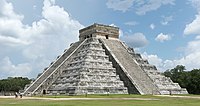
Back أديان أمريكية أصلية Arabic Religiones nativas americanas Spanish دین بومیان آمریکا Persian Az amerikai őslakók vallása Hungarian Ruchy religijne Indian Polish Amerikanska urfolksreligioner Swedish Індіанське язичництво Ukrainian مقامی امریکی مذہب Urdu Tôn giáo của người Mỹ bản địa Vietnamese 美洲原住民宗教 Chinese
Native American religions,[1][2][3][4][5] Native American faith[6] or American Indian religions[7][8][9][10][11] are the indigenous spiritual practices of the Indigenous peoples of the Americas. Ceremonial ways can vary widely and are based on the differing histories and beliefs of individual nations, tribes and bands. Early European explorers describe individual Native American tribes and even small bands as each having their own religious practices. Theology may be monotheistic, polytheistic, henotheistic, animistic, shamanistic, pantheistic or any combination thereof, among others.[12][13][14] Traditional beliefs are usually passed down in the oral tradition forms of myths, oral histories, stories, allegories, and principles.[15][16][17] Nowadays, as scholars note, many American Natives renew their interest in own tradition.[18]
- ^ Brown & Cousins 2001, Front matter.
- ^ Gill 1982.
- ^ Hirschfelder & Molin 2000.
- ^ Melton 2009.
- ^ Paper 2007.
- ^ Garrett & Garrett 2003.
- ^ Underhill 1965.
- ^ Hultkrantz 1979.
- ^ Hultkrantz 1987.
- ^ Zerries 1987.
- ^ Leavelle 2010.
- ^ Brown 1982.
- ^ Paper 2007, Chap. 3.
- ^ Smith, Derek G. (December 3, 2011). "Religion and Spirituality of Indigenous Peoples in Canada". The Canadian Encyclopedia. Retrieved August 28, 2024.
- ^ VÁzquez 1987.
- ^ Kelley 2005.
- ^ Pearce 2012.
- ^ Brown & Cousins 2001, p. 3.


